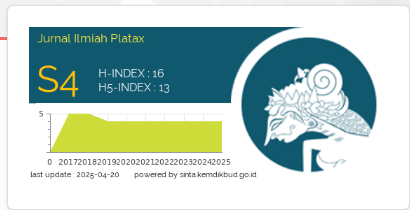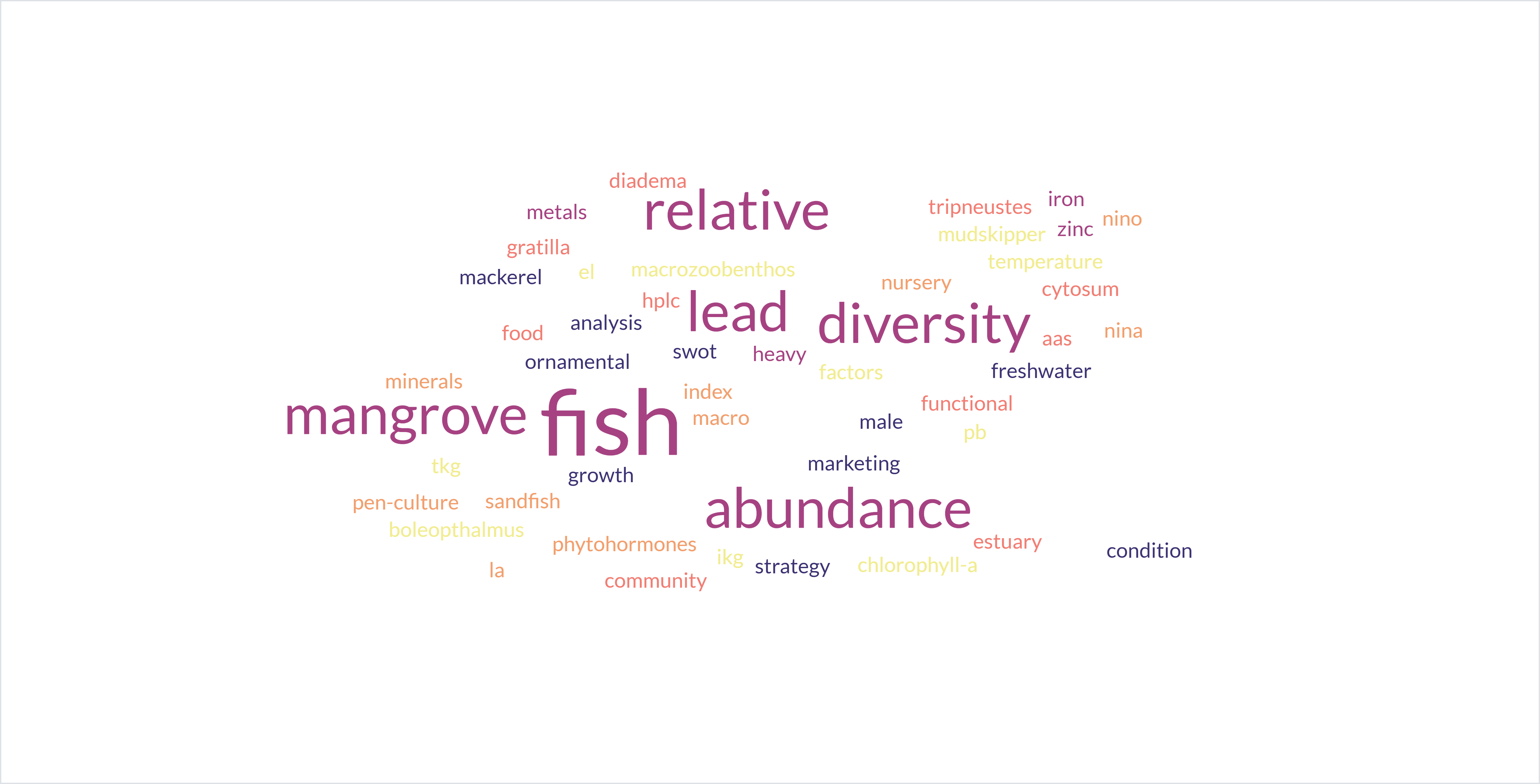Analysis Of Particle Content In Kappaphyccus alvarezii Seaweed In The Waters Of Arakan Village Using Scan Electron Microscopy–Energy Dispersive X-ray Spectroscopy (SEM-EDX)
DOI:
https://doi.org/10.35800/jip.v12i1.51565Keywords:
Bacteria, disease;, infection;, seaweed;Abstract
Kappaphycus alvarezii seaweed is widely cultivated in Indonesia and has important economic value. Nevertheless, this seaweed is easily attacked by diseases. This study was to determine the ice-ice triggers in seaweed farming locations. This research study was conducted at Arakan Village, South Minahasa, North Sulawesi. We performed the bacteria isolation on the infected thallus of Kappaphycus alvarezii and found Staphylococcus arlettae caused the infection. Staphylococcus aureus used to be found on the skin and mucous membranes of healthy humans, while Staphylococcus epidermis inhabits only the skin of healthy humans. Approximately 30% of the normal healthy population was affected by Staphylococcus aureus as it asymptomatically colonizes human hosts. How this Staphylococcus arlettae (mainly found in pork farms) infected Kappaphycus alvarezii which is in a high salinity environment requires an in-depth study. We completed the experiment by using Scan Electron Microscopy–Energy Dispersive X-ray Spectroscopy (SEM-EDX), analysis on infected thallus Kappaphycus alvarezii, and a series of bacteria isolation to observe the morphology and the element contents of Staphylococcus arlettae bacteria has successfully attached to the surface of Kappaphycus alvarezii and caused an infection. This proves that environmental changes have stimulated pathogenic bacteria Staphylococcus arlettae in the area where Kappaphycus alvarezii is cultivated. The mechanism of biosorption by microbes that can live in environments that are contaminated with Pb metal is active uptake. This mechanism occurs simultaneously in line with the consumption of metal ions for the growth of microorganisms. Staphylococcus arlettae are resistant to heavy metals due to the ability to detoxify the influence of heavy metals in the presence of protein or granular material. From the results of the study using SEM-EDX of algae and bacteria Staphylococcus arlettae, it can be concluded that the content of the particle of metal in thallus triggers bacteria to live on the seaweed as an energy source.
Keywords: Bacteria, disease, infection, Kappaphycus alvarezii, seaweed, Staphylococcus arlettae
References
Adi, S.E. and D.S. Nana 2010. Reduction of Pb Ion Concentration in Electroplating Wastewater by Bosorption and Stirring Processes. Journal of Chemical Engineering, 5 (1): 1-9
Ariyanti RW, Widowati LL and Rejeki S. 2016. Performa Produksi Rumput Laut Eucheuma cottoni yang Dibudidayakan Menggunakan Metode Longline Vertikal dan Horizontal. Prosiding Seminar Nasional Ke-V Hasil-hasil Penelitian Perikanan dan Kelautan.
Cappucino, J.G., Sherman, N. 1998. Microbiology: A Laboratory Manual. 5th Edition. California: Benjamin/Cummings Science Publishing. p. 94
Egan, S., and Gardiner, M. (2016). Microbial symbiosis: rethinking disease in marine ecosystems. Front. Microbial. 7:991. DOI 10.3389/fmicb.2016.00991
Franciscon Elisangela, Zille Andrea, Dias Guimaro Fabio, Ragagnin de Menezes Cristiano, Durrant Lucia Regina, Cavaco-Paulo Artur. Biodegradation of textile azo dyes by a facultative Staphylococcus arlettae strain VN-11 using a sequential microaerophilic/aerobic process. International Biodeterioration & Biodegradation 2009, 63 (3), 280-288. DOI: 10.1016/j.ibiod.2008.10.003.
Fernandes, N., Steinberg, P., Rusch, D., Kjelleberg, S., and Thomas, T. (2012). Community structure and functional gene profile of bacteria on healthy and diseased thalli of the red seaweed Delisea Pulchra. PloS One 7:e50854. DOI 10.1371/journal.pone.0050854
Fitrian T. 2015. Hama penyakit (ice-ice) pada budidaya rumput laut studi kasus: Maluku Tenggara. Oseana, Volume XL, Nomor 4, Tahun 2015 : 1-10
Gerung GS., Ngangi ELA. 2017. Grand Design Kawasan Pengembangan North Sulawesi Marine Education Center. FPIK Unsrat dan DKP Sulawesi Utara. Manado.
Hurtado, A. Q., 2013. Sosio-Economic Dimensions of seaweed in The Philippines. In; Hishamuda, and D. Valderrama(eds). Social and Economic Dimenssions of seaweed Cultivation: Assessment and Case Studies. Fao FisheriesAnd Aquaculture Technical Paper 580. FAO. pp 91-113
Irmawati Y. and Sudirjo F. 2017. Infection Vibrio sp. Bacteria on Kappaphycus Seaweed Varieties Brown and Green. IOP Conf. Ser.: Earth Environ. Sci. 89012016
Kasim M. and Mustafa A. 2017. Comparison growth of Kappaphycus alvarezii (Rhodophyta, Solieriaceae) cultivation in floating cage and longline in Indonesia. Aquaculture Reports 6, 49-55
Lachnit T, Brummel M, Imhoff JF, Wahl M. 2009. Specific epibacterial communities on macroalgae: phylogeny matters more than habitat. Aquat Biol 5: 181-186
Largo, D.B., Fukami K. and Nishijima T. 2012. Occasional pathogenicbacteria promoting ice-ice disease in the carrageenan producing red algae Kappaphycus alvarezii and Eucheuma denticulatum (Solieriaceae, Gigartinales, Rhodophyta). J. Appl. Phycol. 7: 545–554.
Martinez J.N and Padilla P.I.P. 2017. Rotten thallus of Red Seaweed, Gracilariopsis heteroclada Zhang et Xia, is Associated with Agar-Digesting Bacillus spp. Journal of Fisheries Sciences.com., 11(4): 034-040
Mendoza, W.G., N.E. Montano, E.T. Ganzon-Fortes and R.D. Villanueva. 2002. Chemical and gelling profile of ice-ice infected carrageenan from Kappaphycus striatum (Schmitz) Doty ‘‘sacol’’ strain (Solieriaceae, Gigartinales, Rhodophyta). J. Phycol.14: 409–418.
Ngangi, E.L.A., J. Mudeng, and J. N. Schaduw. 2012. Implementation and Evaluation of Seaweed Cultivation Management Process in the Minahasa Region of North Sulawesi Province. MP3EI Research Report. Unsrat Research Institute. Manado Ngangi, E.L.A., J. Mudeng, and J. N. Schaduw. 2012. Implementation and Evaluation of Seaweed Cultivation Management Process in the Minahasa Region of North Sulawesi Province. MP3EI Research Report. Unsrat Research Institute. Manado
Noor MN. 2015. Analisis Kesesuaian Perairan Ketapang, Lampung Selatan Sebagai Lahan Budidaya Rumput Laut Kappapycus alvarezii. Journal Maspari. 7(2):91-100.
Nursidi, Syamsu A.A., Niartiningsih, dan Anshary H. 2017. Pengaruh musim dan parameter lingkungan terhadap produksi karagenan Kappaphycus Alvarezii yang dibudidayakan Di Pulau Saugi Sulawesi Selatan. Jurnal Balik Diwa, Vol. 3, No. 2, 47-52
Onyango, L. A., and Alreshidi, M. M. 2018. Adaptive metabolism in Staphylococci: survival and persistence in environmental and clinical settings. J. Pathog., 1-11. doi: 10.1155/2018/1092632
Pang, T., Liu, J., Liu, J., and Li, J. 2015. Observations on pests and diseases affection a eucheumatoid farm in China. Journal of Applied Phycology, 27, 1975– 1984.
Parenrengi A. dan Sulaeman S. 2007. Mengenal rumput laut Kappaphycus alvarezii. Media Akuakultur. Vol. 2, No.1. 142-146
Rama R., La Ode M.A., Wa Iba, Abdul R.N., Armin A. and Yusnaeni Y. 2018. Seaweed Cultivation of Micropropagated Seaweed (Kappaphycus alvarezii) in Bungin Permai Coastal Waters, Tinanggea Sub-District, South Konawe Regency, South East Sulawesi. IOP Conf. Ser.: Earth Environ. Sci.175 012219
Ruperez, P. 2002. Mineral content of edible marine seaweeds. Food Chemistry 79: 23–26.
Runtuboy, N. 2004. Dissemination of Cottoni Seaweed Cultivation (Kappaphycus alvarezii). Annual Report of the Center for Aquaculture Fiscal Year 2003.189-195 p.
Sanz S., Olarte C., Alonso C.A., Hidalgo-Sanz R., Gomez P., Ruiz-Ripa L., Torres C. 2018. Identification of Enterococci, Staphylococci, and Enterobacteriaceae from Slurries and Air in and around Two Pork Farms. J Food Prot (2018) 81 (11): 1776–1782.
Solis M.J.L, Draeger S. and Dela Cruz T.E.E. 2010. Marine-derived fungi from Kappaphycus alvarezii and K. striatum as potential causative agents of ice-ice disease in farmed seaweeds. Botanica Marina 53, 587–594
Sukma Qumain, Dharmawan Agus, Sitoresmi Prabaningtyas, 2016. Comparative Analysis Of Heavy Metal Head (Pb) Comparison In Seaweed and Jelly at Kupang Village, Jabon, Sidoarjo. Journal-online.um.ac.id
Surni WA. 2014. Pertumbuhan rumput laut (Eucheuma cottonii) Pada kedalaman air laut yang berbeda Di dusun Kotania Desa Eti Kecamatan Seram Barat Kabupaten Seram Bagian Barat. Jurnal Biopendix x, 1 (1), 2014
Syafitri E, Prayitno S B, Ma'ruf W F and Radjasa O K. 2017. Genetic diversity of the causative agent of ice-ice disease of the seaweed Kappaphycus alvarezii from Karimunjawa island, Indonesia. IOP Conf. Ser.: Earth Environ. Sci.55 012044
Thillaivasan M., Kumar K., and Silvakumar K. 2019. Seasonal variation in elemental composition of certain seaweeds from Mandapam and Kilakarai coast, Gulf of Mannar biosphere reserve. World Scientific News, 129, 147-160
Tuiyo R. 2016. Budidaya alga laut (Kappaphycus alvarezii) dalam kantong plastik dengan menggunakan teknologi basningro. UNG Press Gorontalo. 71 hal.
Vairappan C.S, Chong S.C., Hurtado A. Q., Soya F.E., Lhonneur G.B., and Critchley A. 2011. Distribution and symptoms of epiphyte infection in major carrageenophyte-producing farms. J Appl Phycol 20(5):27-33. DOI 10.1007/s10811-007-9299-8
Zozaya-Valdes, E., Egan, S., and Thomas, T. (2015). A comprehensive analysis of the microbial communities of healthy and diseased marine macroalgae and the detection of known and potential bacterial pathogens. Front. Microbiol 6:146. doi: 10.3389/fmicb.2015.00146
Downloads
Published
How to Cite
License
Copyright (c) 2023 Sandra Tilaar, Stenly Wullur, Esther Angkouw

This work is licensed under a Creative Commons Attribution-NonCommercial 4.0 International License.
COPYRIGHT
Authors who publish with this journal agree to the following terms:
Authors hold their copyright and grant this journal the privilege of first publication, with the work simultaneously licensed under a Creative Commons Attribution License that permits others to impart the work with an acknowledgment of the work's origin and initial publication by this journal.
Authors can enter into separate or additional contractual arrangements for the non-exclusive distribution of the journal's published version of the work (for example, post it to an institutional repository or publish it in a book), with an acknowledgment of its underlying publication in this journal.
Authors are permitted and encouraged to post their work online (for example, in institutional repositories or on their website) as it can lead to productive exchanges, as well as earlier and greater citation of the published work (See The Effect of Open Access).






































